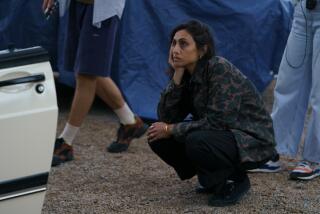MOLIERE’S ERA PAINTED WITH DETAILED STROKES
- Share via
To watch Ariane Mnouchkine’s superb “Moliere” is like seeing a Flemish Old Master painting come alive, with its sensitive play of light and shadow.
This exhilarating account of the great 17th-Century playwright is painted in scenes ranging from cruelty and desperate poverty to pastoral beauty and dazzling pageantry. The France of this 4-hour, 15-minute film stretches gloriously from the gutter to Versailles. Unavailable since a one-week local run in 1980, this 1978 production will screen Wednesday only at 7 p.m. at the Academy of Motion Picture Arts and Sciences, 8949 Wilshire Blvd., as a benefit for Stages, the theater center in Hollywood.
Avoiding all the cliches of film biographies, Mnouchkine evokes a sense of time and place with the power that results from an inspired fusion of research and imagination. She and her celebrated Theatre du Soleil--with many of the players from her Olympic Arts Festival performances--re-create the tumultuous era in which Moliere (1622-1673) lived so vividly and with such persuasive authenticity that their film seems a record of the raw material from which the playwright fashioned his art. In the process, the film itself becomes a work of art, a stunning epic saga of immense personal courage and achievement.
In the title role, Philippe Caubere seems to mature with Moliere, portraying him as a determined youth who becomes an acclaimed yet ever controversial playwright. Don’t be put off by the film’s length any more than by the length of the company’s live performances: It overflows with such passion and vitality that it sweeps us along to the very end. For ticket information, call Stages at (213) 465-1010.
Significantly, three of the four films screening Saturday and Sunday in the Mikio Naruse series at UCLA Melnitz conclude, like Chaplin’s “Modern Times,” with two people walking together down a road.
By the ‘50s, Naruse had come out of a 15-year slump attributed to an unhappy marriage and was able to temper his characteristic pessimism with the possibility that there could be some kind of reconciliation with life. The ‘50s and early ‘60s--he died in 1969--is probably his finest period, and all four of these highly contemplative, keenly observant films have the impact of fully realized works. Each film has images sure to linger in the mind, and surely unforgettable is the expression on the incomparable Kinuyo Tanaka’s face in “Mother” as she gazes with loving pride upon her daughter donning a wedding gown.
All four are quite varied dramas of lower-middle-class family life, and all are graced by the decade’s top stars in some of their finest performances. The 1952 “Mother” (Saturday at 7:30 p.m. with “Lightning”) tells of a loving, indomitable matriarch (Tanaka, who also made Mizoguchi’s “The Life of Oharu” the same year) determined to sustain her family through the hardships of the postwar era. The central figure of “Lightning” (1952) is not the mother (Kumeko Urabe) but her one admirable daughter (Hideko Takamine), intent upon escaping from her mother and her sisters, one of them as grasping as the other is defeated.
As bitter and explosive as domestic life is in “Lightning,” it is even more intense in the 1953 “Older Brother, Younger Sister” (Sunday at 7:30 p.m.), which has to do with a modest rural family devastated by the scandalous pregnancy of its eldest unmarried daughter (Machiko Kyo).
The 1953 “Husband and Wife,” screening after “Older Brother, Younger Sister,” tells what happens when a self-absorbed office worker (Ken Uehara) and his pretty, smiling wife (Yoko Sugi) move in with a handsome young widower (Rentaro Mikuni). A side issue of the film is abortion, a subject taboo in the West at the time.
Also screening at UCLA this week is an evening of short German experimental films (Tuesday in Melnitz Theater at 7:30 p.m), hosted by film maker Bastian Cleve.
More to Read
The biggest entertainment stories
Get our big stories about Hollywood, film, television, music, arts, culture and more right in your inbox as soon as they publish.
You may occasionally receive promotional content from the Los Angeles Times.










